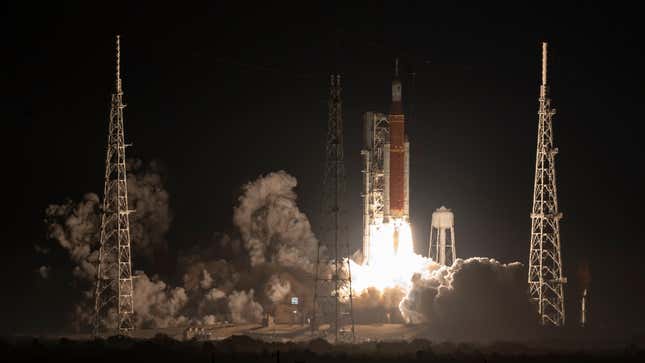
During the early hours of Wednesday morning, James Rice waited anxiously at Kennedy Space Center’s Banana Creek viewing platform in Florida as NASA’s Moon rocket geared up for its inaugural liftoff. “Today I saw a piece of history,” Rice, associate director at Arizona State University’s School of Earth and Space Exploration, told Gizmodo in an email.
The planetary scientist, who also works on NASA’s Perseverance rover mission, was at the space center for both previous failed launch attempts in August and September. But yesterday, the massive Space Launch System (SLS) finally took off from Launch Pad 39B, launching at 1:47 a.m. ET and initiating an entirely new era of lunar and space exploration.
“The light was blinding and literally turned night into day,” Rice said. “Seconds later came that ominous rumbling sound building to a crescendo accompanied by its attendant vibrations, it was a staccato sound somewhat like a giant gurgling fire with chest pounding vibrations.” To which he added: “It was so much more intense and powerful than any Shuttle launch I have witnessed over the years.”
The Artemis 1 mission launch was celebrated not only as a continuation of the Apollo era, but the beginning of a new one that is set to inspire its own generation to explore the Moon and beyond.
The SLS rocket carefully delivered the Orion capsule on a 25.5-day journey to the Moon and back, testing out the integrated system for the first time in order to prepare for subsequent missions that are meant to return humans to the Moon no earlier than 2025. Since the Apollo missions ended in 1972, astronauts have not taken dusty strides across the lunar surface. But Artemis is set to change that, and do so under largely different circumstances.
“When the Apollo mission went up, we didn’t really know what we were doing scientifically,” Jason Steffen, physics and astronomy professor at the University of Nevada, told Gizmodo during a phone interview. “The Apollo program was really a military program under the guise of a scientific endeavor.”
Since then, space exploration has advanced well beyond the days of Apollo, and scientists are more aware of how to handle samples from another celestial body. “In the last half a century, NASA, and scientists in general, have refined the protocols that we put in place about how to treat samples,” Steffen said.
The past 50 years or so have seen a rise in robotic missions to the Moon, Mars, as well as other cosmic destinations. But Artemis marks a return to crewed missions, with the intent of establishing a sustainable presence on the Moon that may one day lead to landing astronauts on Mars. Indeed, Artemis is meant to get us back to the Moon, but it’s also serving as a precursor program for a future Mars initiative.
“It’s a lot cheaper to build a rover than it is to send a person there because the rover, you can kill it...you don’t have to bring it back,” Steffen said. While it’s true that you can’t just leave astronauts stranded on other planets, having them on the Moon does add some value to the mission in terms of them being able to make decisions on the surface based on what they see in front of them.
“The Artemis Program is going to get us back to the exciting and important business of exploring another world by getting our boots dirty again,” Rice said.
There is also a quality to witnessing humanity achieve certain feats like landing on the Moon. “I view the return to the surface of another celestial object as humans reclaiming a spot in the universe that we haven’t been to in a long time,” Steffen said. “And I think that’s inspiring.”
More: NASA’s Moon-Bound Orion Spacecraft Captures Goodbye Pic of Earth